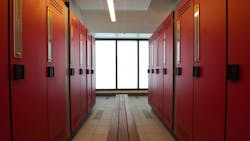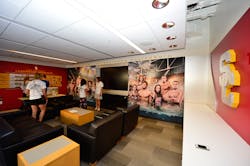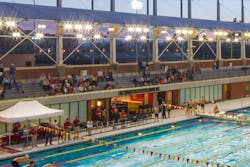In the design of locker rooms for athletic teams, each sport has its own set of benchmarks for adjacencies, locker size, materials selection and the like. But the actual locker rooms that result vary widely, because of the culture of the particular team, athletic department or institution. Designers have to be attuned to these differences, and find ways to make spaces “special” — not just from an aesthetic perspective, but with details that highlight a school’s unique attributes.
Does a team hang out together after practices or games? Is the locker room, the team lounge or some other nearby space the preferred location? Do the athletes view the locker room as their private inner sanctum, or are others welcome to enter? How “present” are coaches and staff? The answers to these and dozens of other questions influence the final locker room design.
The Wet Look
Aquatics locker rooms, for recreational as well as competitive venues, have standards all their own. The wet environment in particular has a huge impact on adjacencies, mechanical systems and materials selection. For example, it is ironclad in a pool environment that swimmers enter the locker room from a “dry side” and exit to the pool through a wet zone that includes sinks, toilets and showers. Similarly, lockers will most often be specified in a phenolic or plastic material that can withstand moisture, and be vented to allow the infiltration of air circulation, aiding drying.
When athletic teams are part of the mix, however, other issues come to the fore. Sometimes, simple site issues can have a surprising effect. For instance, the new Uytengsu Aquatics Center at the University of Southern California was built on an extremely tight site between the school’s football practice field and an existing recreation center. This necessitated that the locker rooms inhabit a long, narrow space between the pool deck and south wall, which runs along the field’s end zone. It proved difficult to introduce windows along that wall because of the potential damage from high-speed footballs kicked or thrown during practice.
Thus, it became necessary to pursue other means of bringing natural daylight into the locker rooms and ancillary areas under the aquatics center’s grandstand. These circumstances pointed toward a particular configuration that was fleshed out after spending time with the athletes and listening to their take on locker room space.
Locker Room Culture
USC’s Trojans have won 10 national swimming and diving championships, and the school’s water polo teams have won 13 — the men added their sixth in a row this past season. This winning culture is aided in part by a unique fellowship among the men’s and women’s swimming, diving and water polo teams, which view themselves as one team. This unity led directly to the decision to place a shared athletes’ lounge between the men’s and women’s locker rooms. (Many team locker rooms include separate team lounges within the individual locker rooms.)
The lounge is outfitted with comfortable furniture, refrigerators for storing healthy snacks and drinks, TVs, video games and a Foosball table. Centered on the 50-meter pool, the lounge opens to the pool deck via glass panels that slide, swing and stack against the wall, making the lounge an extension of the pool deck. It is a space for reviewing video, studying and socializing, and is integral to the locker rooms on either side.
Its central placement, the building’s narrow footprint and the inviolable nature of the locker rooms’ back wall led to a second major departure from typical pool locker rooms. Both wet and dry entry into each locker room is from the pool deck, a mixing up of zones that helped shape the layout and materials selection. The men’s and women’s locker rooms can each be entered via a dry entry on the pool deck next to the shared lounge, or through the lounge itself. The wet entries are located on the far side, with the standard progression of locker area to restroom and shower zone and out to the deck. Anticipating the realities of wet and dry entries all located on a presumed wet pool deck and used by athletes in wet bathing suits, walk-off draining mats were used in vestibules next to the lounge, and non-absorbent, vinyl-backed carpeting was installed in the lounge that can be air-dried or wet-vacuumed.
One last key visual element of the USC locker rooms is the inclusion of daylighting along the pool deck. The north-facing translucent panels on either side of the lounge consist of insulated, laminated glass designed to withstand the impact of a 50-mile-per-hour water polo ball. A fire-etched frit on the inside face of the glass and translucent vinyl in the laminated glass layer permit diffuse light while maintaining privacy for locker room users.
Meeting Team Storage Needs
Understanding locker room operations is another prerequisite to the design and layout of these spaces. For example, a locker room that serves three teams (swimming, diving and water polo) could feature separate alcoves so teams dress together, but this might lead to locker room bottlenecks. USC’s configuration — again, demonstrating its team-first approach — distributes the different teams throughout the locker space. To limit moisture in locker rooms, USC also specified a separate wet room equipped with floor drains, where athletes hang wet bags (for kick boards, fins, paddles and snorkels), training parachutes, backstroke flags and polo caps. Space is also included for heavier gear such as leg weights and racks for medicine balls and water polo balls.
Locker selection in team locker rooms is dependent on many factors, from storage needs to local climate to the inclinations of the athletes. Sizes can range from about 24 inches wide for football and basketball to 12 inches for a standard day locker. Lockers at the Uytengsu Aquatics Center are just 15 inches wide, because of limited space and a paucity of storage needs, but also because of the pragmatic swim culture. With bulkier training items stored separately, the lockers provide enough room for personal items, swimsuits and parkas.
An athletic program’s resources are usually seen as the determining factor in the size and scope of team locker rooms — but the people matter more. A designer’s job is to listen to the needs of the space’s users so the space can be visualized that will meet everyone’s needs.
HAYTON, AIA, LEED AP BD+C ([email protected]) is an associate principal with ELS Architecture and Urban Design in Berkeley, Calif.


